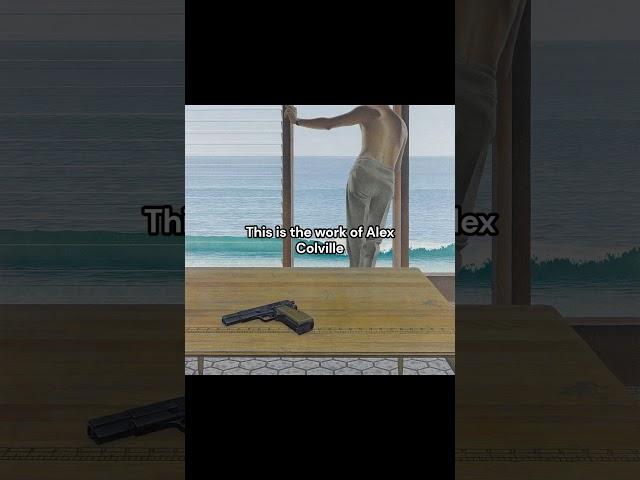
The 2000s want their game graphics back | The work of Alex Colville (From 1950s–1990s) #art
Alex Colville first developed a taste for art during a six-month bed rest after contracting pneumonia. Isolated from his family and friends, he had only the books and art materials his mother provided to occupy his time. His first formal art education came through weekly classes with Sarah Hart, who taught him to paint in a Post-Impressionist style.
He later attended Mount Allison University, where he was introduced to a traditional curriculum focused on drawing and painting from life, as well as copying from classical casts and nineteenth-century works.
After graduating from university, Colville enlisted in the First Canadian Army with aspirations of becoming a war artist. He served in a non-combatant role for the first two years before being transferred to London, England, where he was officially appointed as a war artist. He spent the next two years documenting Canada’s war effort in England and on the continent.
During his time as a war painter, he had the opportunity to visit the Louvre—if only briefly. As Colville wrote: “I realized that it might take me years, for instance, to absorb the effects of the two days I spent in the Louvre.” He was also present at the liberation of the Bergen-Belsen concentration camp.
After the war, Colville’s style went through several phases of experimentation. He believed that painting was a form of thinking. He identified as a “conceptual” artist—not in the contemporary art historical sense, but in that he constructed images from both found and imagined elements.
Colville’s painting style gradually moved toward pointillism. However, unlike the expressive pointillism of Seurat and Signac, his technique involved tiny, controlled marks of color applied with fine brushes, avoiding visible strokes. He layered colors without mixing them on the brush and glazed the surface to achieve a seamless finish. His compositions were also built on a strict geometric structure—a hallmark he developed in the early 1950s and maintained throughout his career. While he initially worked in tempera and oil, he switched entirely to acrylics by the mid-1960s.
Paintings:
Dog and Bridge (1976)
Pacific (1967)
Traveller (1992)
Horse and Train (1954)
To Prince Edward Island (1965)
Swimming Race (1958)
Cattle Show (1955)
He later attended Mount Allison University, where he was introduced to a traditional curriculum focused on drawing and painting from life, as well as copying from classical casts and nineteenth-century works.
After graduating from university, Colville enlisted in the First Canadian Army with aspirations of becoming a war artist. He served in a non-combatant role for the first two years before being transferred to London, England, where he was officially appointed as a war artist. He spent the next two years documenting Canada’s war effort in England and on the continent.
During his time as a war painter, he had the opportunity to visit the Louvre—if only briefly. As Colville wrote: “I realized that it might take me years, for instance, to absorb the effects of the two days I spent in the Louvre.” He was also present at the liberation of the Bergen-Belsen concentration camp.
After the war, Colville’s style went through several phases of experimentation. He believed that painting was a form of thinking. He identified as a “conceptual” artist—not in the contemporary art historical sense, but in that he constructed images from both found and imagined elements.
Colville’s painting style gradually moved toward pointillism. However, unlike the expressive pointillism of Seurat and Signac, his technique involved tiny, controlled marks of color applied with fine brushes, avoiding visible strokes. He layered colors without mixing them on the brush and glazed the surface to achieve a seamless finish. His compositions were also built on a strict geometric structure—a hallmark he developed in the early 1950s and maintained throughout his career. While he initially worked in tempera and oil, he switched entirely to acrylics by the mid-1960s.
Paintings:
Dog and Bridge (1976)
Pacific (1967)
Traveller (1992)
Horse and Train (1954)
To Prince Edward Island (1965)
Swimming Race (1958)
Cattle Show (1955)
Тэги:
#HistoryShorts #HistoricalFacts #HistoryInMinutes #QuickHistory #HistorySnippets #LearnHistory #HistoryLessons #HistoryTidbits #ShortHistory #HistoryForKids #EducationalHistory #HistoryTrivia #FamousEvents #HistoricalFigures #AncientHistory #WorldHistory #HistoryChannel #HistoryVideos #HistoryStories #HistoryOfTheWorldКомментарии:
All New Piko Design # by pico Master guru
Pico Master guru
#поздравления #Амурск
Праздник Амурск
vibrator machine #shorts #machinery #road
RoadMade Machine
Rihanna aka the Gloss Bo$$ celebrated the launch of #GlossBombOil in Paris ️
Fenty Beauty By Rihanna
The Broken Science Initiative: Let's start with the truth
The Broken Science Initiative







![[김포빌라매매] 신축빌라가 1억5천9백? 다시는 없을 이 가격! 마지막 한세대 김포시 통진읍 마송리 신축빌라 [김포빌라][김포빌라분양][통진신축빌라][김포신축빌라] [김포빌라매매] 신축빌라가 1억5천9백? 다시는 없을 이 가격! 마지막 한세대 김포시 통진읍 마송리 신축빌라 [김포빌라][김포빌라분양][통진신축빌라][김포신축빌라]](https://rtube.cc/img/upload/SU9zREEzR3M4LU8.jpg)


















